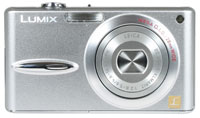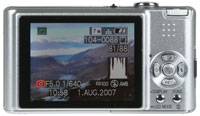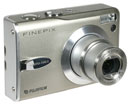Panasonic Lumix DMC-FX30
-
-
Written by Gordon Laing
Panasonic Lumix DMC-FX30 Verdict
The Panasonic Lumix DMC-FX30 is certainly a very nice compact to carry around and use. It’s slim enough to slip discreetly into most pockets, built to a very high standard, delivers a useful zoom range with a 28mm wide angle, and gives you quick and easy access to most of the key settings.
 |
 |
Sounds great right? And it is, but there’s one big snag, and it’s something that’s becoming sadly predictable with today’s compacts: image quality. Like most compacts, the FX30 has visible noise across its entire range of sensitivities when you view images on-screen at 100%, even when set to the lowest 100 ISO setting. There’s no getting away from it, and the quality plummets at higher sensitivities. See our FX30 Outdoor Noise results to see what we mean.
The important thing to remember though is this noise is only a serious problem if you’re examining images on-screen at 100%, or making big prints. If you prefer to view your entire images at once or make smaller prints, then it becomes much less of an issue. And to be fair this is a problem which also faces most compacts these days, so while Panasonic’s models suffer in this respect, they’re certainly not alone.
The fact is, if you want to view images at 100% on-screen and marvel at noise-free detail, you won’t get it with a compact – you need a DSLR instead. So with that in mind, how does the FX30 measure-up against the best of rest?
Compared to Panasonic Lumix DMC-TZ3
Panasonic’s Lumix TZ3 is one of our favourite compacts right now. It may be chunkier than the FX30, but instead of an average 3.6x zoom, the TZ3 boasts nothing less than a 10x optical range. So you’re getting a super-zoom which can squeeze into most pockets, and the range also starts at an equivalent of 28mm for those wide angle shots. Panasonic’s additionally squeezed a bigger 3in screen on the back which is great for both composition and playback.
On the downside the TZ3 suffers from the same noise issues as the FX30, but on the upside it does offer a neat option where the lens coverage is maintained even when you adjust the image aspect ratio. Bottom line: if you’d find the 10x range handy and don’t need the slimmest compact, then go for the TZ3. See our Panasonic Lumix DMC-TZ3 review for more details.
Compared to Canon PowerShot A640
 |
Canon’s PowerShot A640 costs roughly the same as the FX30, but is a completely different kind of compact. It’s considerably bigger, but features 10 Megapixel resolution, a flip-out screen for shooting at unusual angles and a wealth of manual control. On the downside, the A640’s lens doesn’t zoom as wide and there’s also no optical stabilisation.
Ultimately if you prefer a more hands on approach to photography, then the A640 should satisfy your creative desires, but remember with the A640 we’re talking about your coat pocket, not the one on the front of your shirt. See our Canon PowerShot A640 review for more details.
Compared to Fujifilm FinePix F30 / F31fd
 |
Fujifilm’s FinePix F30 / F31fd may be getting on now, but remains the benchmark for compact image quality. While rivals are getting increasingly noisy, the F30 / F31fd holds it together to deliver respectable results even at higher sensitivities – see our FX30 Outdoor Noise results to see what we mean.
On the downside the F30 / F31fd is considerably chunkier than the FX30 and has neither the 28mm wide angle nor the optical stabilisation. It’s physically less desirable, but if you want a compact with the best image quality, it remains hard to beat. Note the F31fd is the same as the F30, but with face detection. See our Fujifilm FinePix F30 review for more details.
Final Verdict
The Panasonic Lumix DMC-FX30 certainly has a great deal going for it. The body is slim and well built, the 28mm lens coverage gives you the flexibility of shooting big landscapes, buildings or group shots, and the dropdown menu system presents easy access to common settings.
The FX30’s Achilles heel, like most compacts, is electronic noise, but depending on your requirements this may or may not be an issue. If you like to examine images on-screen zoomed-into 100%, then be warned the noise will be obvious and at times off-putting – although to be fair this is a problem that’s by no means exclusive to the FX30.
If however you prefer to view a whole image at once or make average sized prints, then the FX30’s noise issues may rarely be an issue. Indeed they’re certainly no worse than most of today’s compacts. It’s a decision you have to make for yourself, but check out our FX30 Sample Images for some examples.
Ultimately if you can live with the noise and mostly automatic controls, then the FX30 is a lovely compact to use. It’s slim and light while packing in a decent lens with genuine wide angle and optical stabilisation. The sensor issues prevent us from awarding our highest recommendation, but since this is par for the course with today’s compacts coupled with the overwhelmingly positive aspects of the FX30, means it’s a model we can still comfortably Recommend.
For a demonstration of the FX30’s headline features, including its zoom range, stabilisation and menu system, check out our Panasonic FX30 video tour.
Good points Bad points |  Scores | |||
Build quality: Image quality: Handling: Specification: Value:
Overall: | 18 / 20 15 / 20 17 / 20 18 / 20 18 / 20
86% | |||





